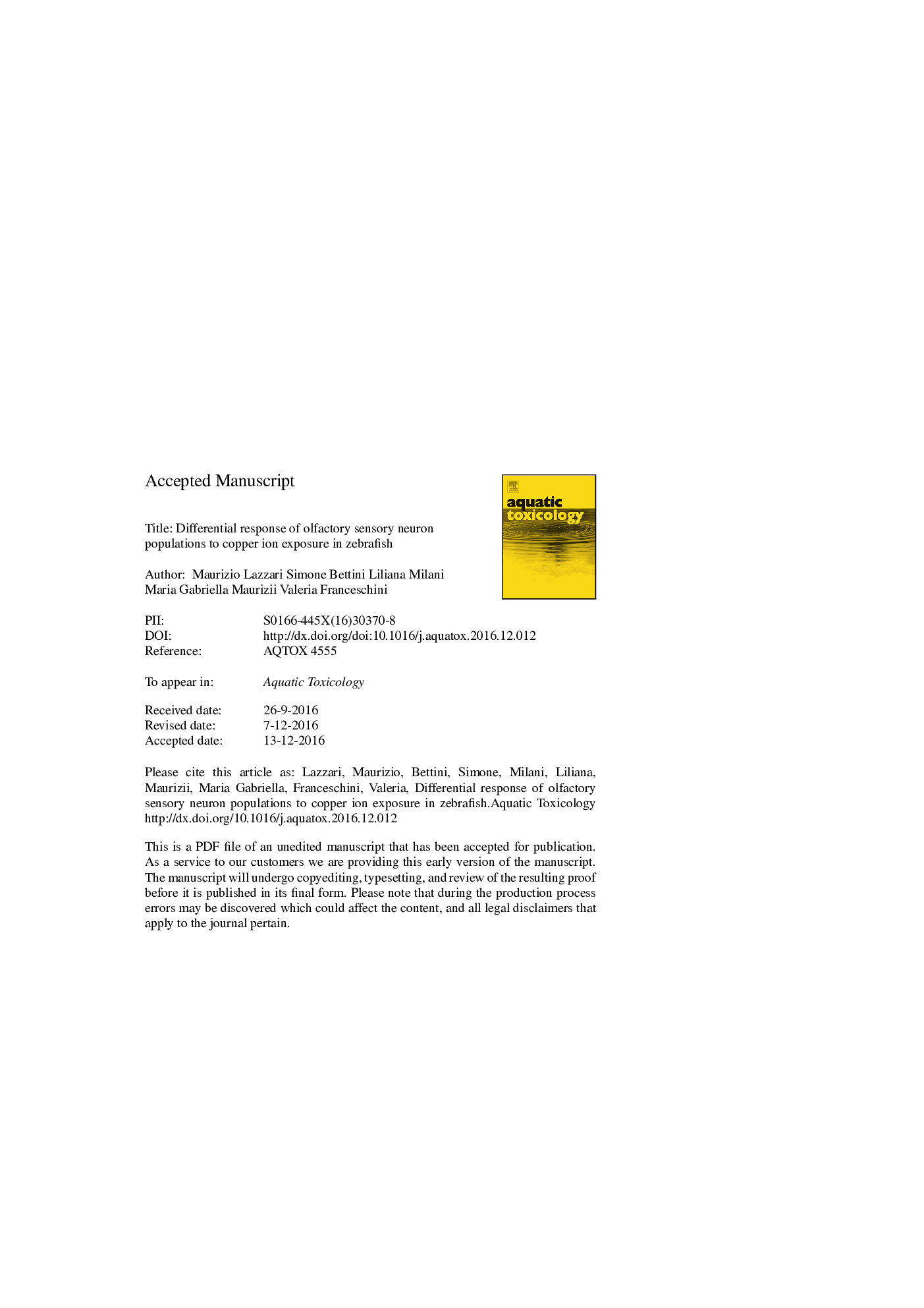| کد مقاله | کد نشریه | سال انتشار | مقاله انگلیسی | نسخه تمام متن |
|---|---|---|---|---|
| 5764201 | 1625922 | 2017 | 37 صفحه PDF | دانلود رایگان |
عنوان انگلیسی مقاله ISI
Differential response of olfactory sensory neuron populations to copper ion exposure in zebrafish
ترجمه فارسی عنوان
پاسخ دیفرانسیل از جمعیت عصبی حنجره بویایی به مواجهه با یون مس در ماهی قزل آلا
دانلود مقاله + سفارش ترجمه
دانلود مقاله ISI انگلیسی
رایگان برای ایرانیان
کلمات کلیدی
یون های مس، اپیتلیوم پوستی عصب های حساس رحمی، سلولهای خزنده، بازیابی رفلاکس ماهی قزل آلا، ایمونوهیستوشیمی،
موضوعات مرتبط
علوم زیستی و بیوفناوری
علوم کشاورزی و بیولوژیک
علوم آبزیان
چکیده انگلیسی
The peripheral olfactory system of fish is in direct contact with the external aqueous environment, so dissolved contaminants can easily impair sensory functions and cause neurobehavioral injuries. The olfactory epithelium of fish is arranged in lamellae forming a rosette in the olfactory cavity and contains three main types of olfactory sensory neurons (OSNs): ciliated (cOSNs) and microvillous olfactory sensory neurons (mOSNs), common to all vertebrates, and a third minor group of olfactory neurons, crypt cells, absent in tetrapods. Since copper is a ubiquitously diffusing olfactory toxicant and a spreading contaminant in urban runoff, we investigated the effect of low copper concentration on the three different OSNs in the olfactory epithelium of zebrafish, a model system widely used in biological research. Image analysis was applied for morphometry and quantification of immunohistochemically detected OSNs. Copper exposure resulted in an evident decrease in olfactory epithelium thickness. Moreover, after exposure, the lamellae of the dorsal and ventral halves of the olfactory rosettes showed a different increase in their sensory areas, suggesting a lateral migration of new cells into non-sensory regions. The results of the present study provide clear evidence of a differential response of the three neural cell populations of zebrafish olfactory mucosa after 96 h of exposure to copper ions at the sublethal concentration of 30 μg Lâ1. Densitometric values of cONS, immunostained with anti-G αolf, decreased of about 60% compared to the control. When the fish were transferred to water without copper addition and examined after 3, 10 and 30 days, we observed a partial restoration of anti-G αolf staining intensity to normal condition. The recovery of cOSNs appeared sustained by neuronal proliferation, quantified with anti-PCNA immunostaining, in particular in the early days after exposure. The densitometric analysis applied to mOSNs, immunostained with anti-TRPC2, revealed a statistically significant decrease of about 30% compared to the control. For cOSNs and mOSNs, the decrement in staining intensity may be indicative of cell death, but reduction in antigen expression may not be excluded. In the post-exposure period of 1 month we did not find recovery of mOSNs. We hypothesize that cOSNs are more sensitive than mOSNs to copper treatment, but also more prompted to tissue repair. Anti-TrkA-immunopositive crypt cells appeared not to be affected by copper exposure since statistical analysis excluded any significant difference between the control and treated fish. Comparative studies on OSNs would greatly enhance our understanding of the mechanisms of olfaction.
ناشر
Database: Elsevier - ScienceDirect (ساینس دایرکت)
Journal: Aquatic Toxicology - Volume 183, February 2017, Pages 54-62
Journal: Aquatic Toxicology - Volume 183, February 2017, Pages 54-62
نویسندگان
Maurizio Lazzari, Simone Bettini, Liliana Milani, Maria Gabriella Maurizii, Valeria Franceschini,
